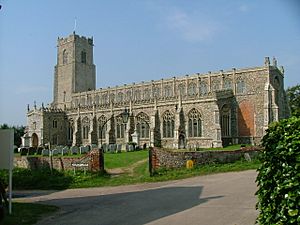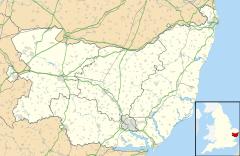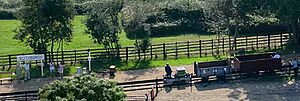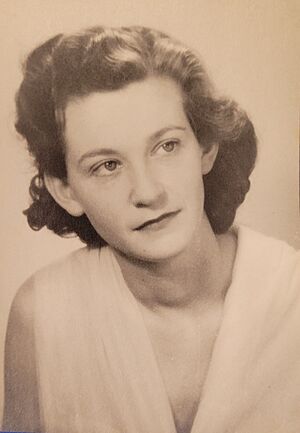Blythburgh facts for kids
Quick facts for kids Blythburgh |
|
|---|---|
 Holy Trinity Church, Blythburgh |
|
| Population | 297 |
| OS grid reference | TM4575 |
| District |
|
| Shire county | |
| Region | |
| Country | England |
| Sovereign state | United Kingdom |
| Post town | Halesworth |
| Postcode district | IP19 |
| EU Parliament | East of England |
| UK Parliament |
|
Blythburgh /ˈblaɪðbərə/ is a small village in Suffolk, a county in England. It's about 4 miles (6.4 km) west of Southwold and 5 miles (8 km) southeast of Halesworth, right by the River Blyth. The A12 road goes through the village, splitting it into two parts. In 2011, about 297 people lived there. Two tiny settlements, Bulcamp and Hinton, are also part of Blythburgh.
Blythburgh is famous for its beautiful church, Holy Trinity. People often call it the "Cathedral of the Marshes" because it's so grand. Since the 1960s, the church has been lit up at night, making it a clear landmark for drivers on the A12. The village was also home to Blythburgh Priory, a type of monastery. It was started by Augustine monks from St Osyth's Priory in Essex in the 1100s. The priory closed down in 1537, but you can still see its old ruins today.
The village is located in the Suffolk Coast and Heaths area, which is a special place known for its natural beauty. It's also close to the Suffolk heritage coast. The area around the River Blyth has lots of marshland and mud-flats. These areas were intentionally flooded in 1940 to help protect Britain during World War II.
Contents
Exploring Blythburgh's Past
Blythburgh has a long and interesting history, stretching back many centuries.
Ancient Battles and Burials
North of the village, you'll find the site of the Battle of Bulcamp. This battle happened around 653 or 654. It was fought between the forces of Anna of East Anglia, who was the King of East Anglia, and Penda of Mercia. King Anna was defeated and killed, along with his son Jurmin. Many believe they were both buried near where Blythburgh Priory would later be built.
Blythburgh in the Domesday Book
In 1086, a big survey called the Domesday Survey was done across England. Blythburgh was listed as a very large village with 42 households. It was called Bledeburo, Blieburc, or Blideburc back then. The village was an important port and had to pay 3,000 herrings in tax each year! Bulcamp and Hinton were listed separately, each with eight households.
The Priory's Story
Blythburgh Priory was founded by Augustine monks in the 12th century. It was a religious house where monks lived and prayed. The priory closed in 1537, and today, only ruins remain. This site is protected as a "scheduled monument," meaning it's an important historical place. In 2008, the TV show Time Team even did an archaeological dig there.
River Trade and Workhouses
The River Blyth became very shallow by the 1700s. By the 1750s, traders from nearby Halesworth wanted to make the river usable for boats again. An Act of Parliament was passed in 1757, and after four locks were built, boats could use the river by 1761. However, by the late 1800s, the river became too shallow again, and the locks finally closed in 1934.
Bulcamp, located on the northern edge of Blythburgh, was once the site of the Blything Union workhouse. This building was constructed in 1765-66. Later, it became a hospital for older people. Today, it has been changed into homes.
World War II History
During World War II, Joseph P. Kennedy, Jr., who was the older brother of future US President John F. Kennedy, was killed near Blythburgh. His aircraft exploded about 1 mile (1.6 km) south of the village. He and another pilot were flying a special "robot" aircraft for a secret mission.
Blythburgh's Natural Beauty
Blythburgh is surrounded by beautiful landscapes and interesting places.
A milestone marker by the A12 road shows that Blythburgh is 30 miles (48 km) north of Ipswich and 24 miles (39 km) south of Great Yarmouth. The White Hart Inn, a pub owned by Adnams Brewery, is a historic building from the 1500s. It's known for its unique "Dutch gable" ends and old wooden beams inside.
Henham Park, a large estate, is partly within the village's area. This park is famous for hosting the annual Latitude Festival, a big music and arts event. Most of the land south of the village belongs to the Blois family. The parish of Blythburgh includes Bulcamp to the north and Hinton to the southeast.
The village is especially known for its large areas of flooded marshes around the River Blyth. The river flows from west of Halesworth to the North Sea between Southwold and Walberswick. You can reach Southwold by taking the A1095 road, which offers great views over the river and the nearby Hen Reedbeds bird reserve.
The Old Railway Station
Blythburgh railway station used to connect the village to Halesworth and Southwold. This was part of the Southwold Railway, a narrow gauge line that ran from 1879 to 1929.
Today, Blythburgh Station is being restored. There's a period platform, some railway tracks, and other old railway structures. The old coal shed has been fully repaired and is used for railway activities. On special open days, a battery-powered locomotive called 'Greenbat' pulls replica train cars.
Holy Trinity Church: The Cathedral of the Marshes
The main church in Blythburgh is called Holy Trinity Church. It's known as the "Cathedral of the Marshes" because of its impressive size and beauty. Blythburgh was one of the earliest places in East Anglia where Christianity was practiced, and a church is believed to have stood here as early as the 600s. The church you see today is a Grade I Listed building, meaning it's very important. It was built in the 1300s and 1400s.
On August 4, 1577, a famous local legend says that a ghostly black dog known as Black Shuck appeared at the church during a storm.
Famous People Connected to Blythburgh
Blythburgh is mentioned in the song "Black Shuck" by the rock band The Darkness. The song is about the local folk tale of the ghostly dog.
Many interesting people have lived in or been connected to Blythburgh, including:
- William Alwyn - a composer
- Doreen Carwithen - a composer
- Ernest Crofts RA - a military artist
- Kenneth Hubbard - an RAF pilot
- Simon Loftus OBE - a brewer and wine expert
- Sir John Seymour Lucas RA - a portrait painter
- Jack Pritchard - known for Isokon designs
- Martin Shaw - a composer of hymn music
- Peter Harold Wright - a Victoria Cross recipient from World War II





